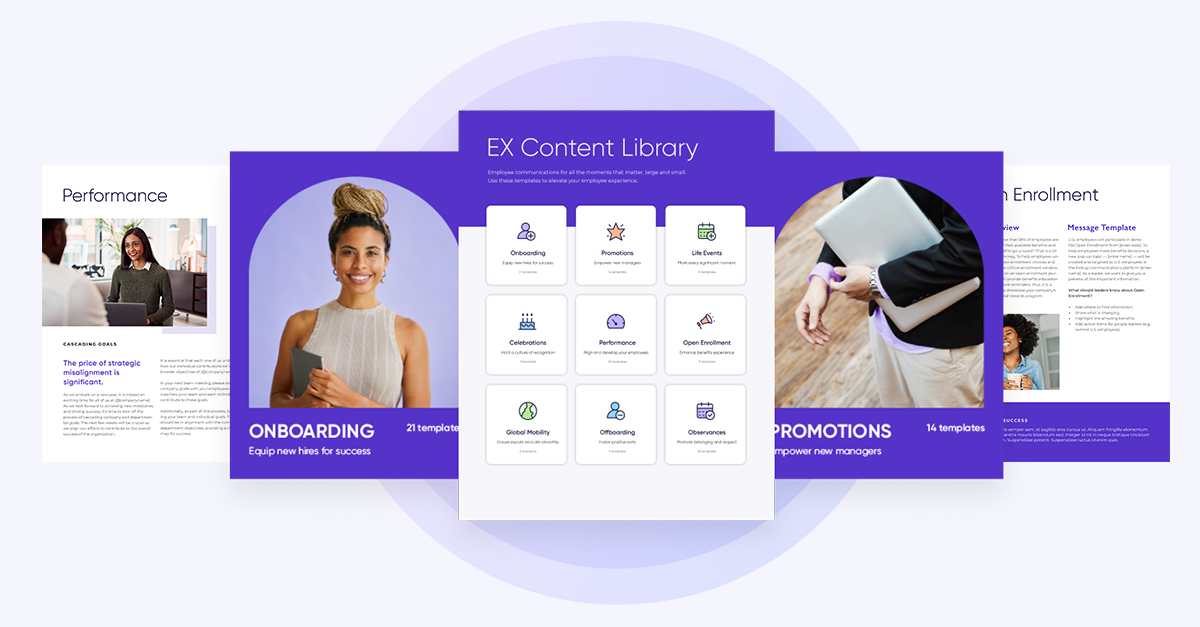Six lessons on how to improve communications
#1 Adopt a multi-channel approach to effectively reach all employees, anywhere
Copying and pasting to publish onto multiple channels doesn’t cut it anymore. Multi-channel communications, driven by the right technology tools, are helping top leaders transform, enhance, and add value to their communications strategies.
Today, communicators finally have their own workforce communications platforms to streamline workflows by automating tedious tasks and integrating across channels. Branded mobile apps, digital signage, printed materials, and intranet messaging are working in combination to connect, inform, and build trust among today’s workforces. Also, multi-channel strategies provide the crucial performance measurement tools communicators need to succeed.
If done well, you’ll reach employees on their terms and on the devices of their choice, which is necessary for frontline or deskless workers who are on the move and may not have a company email address.
#2 Use targeting and personalization to encourage rapid adoption of your initiatives
These communications leaders had rapid adoption with their new initiatives because they met employees where they were, empowered them, and personalized their messaging. In turn, this helped employees become ambassadors for their brands.
Employees who feel disconnected from the business and don’t understand why decisions are being made are less likely to engage with new initiatives—which makes those initiatives more likely to fail. If employees aren’t getting relevant information, they may not understand or even know about company-wide business goals.
Ultimately, the best internal communicators understand their audience and support employee engagement that drives desired business outcomes. And a more connected workforce is a catalyst for improved business results.
#3 Embrace new ways to stay connected to your deskless workers
Top communications leaders are finally recognizing deskless employees, who make up 80% of the global workforce. They’re on the front lines, building and selling products we enjoy, and keeping us healthy. But, without company emails or laptops, they can easily feel disconnected.
Many of these un-wired employees are in industries like retail and hospitality, which can have high attrition and turnover rates, so getting them access to company policies, up-to-date information, and their organization’s brand story is essential.
One way these communications leaders are engaging this overlooked group is with mobile. More than 92% of millennials have smartphones, so deskless employees are most likely already comfortable with mobile. They can quickly check their PTO balance, get the latest corporate news, and sign off on compliance notifications when it’s convenient for them.
#4 Help employees promote your company culture
With the right tools, you can reach employees on their terms and get them involved in your company story. Like the communications leaders we featured, you can even get employees excited to participate in and share your company story.
To do this, look for a good workforce communications platform. The ideal platform can span the entire workforce, integrate with other systems (combining the best from each individual resource), and help you communicate with hard-to-reach employees such as frontline or deskless workers.
Our communicators of change have the mindset of creating culture by communicating their brand story that comes from a company’s own history and activities: the “goodness” of what the company is doing. If you can integrate employees into your company story and make them active participants, they’ll also become stakeholders in the success of any transformation initiative.
#5 Prove communications ROI by measuring performance
Top communications leaders have found that effective employee engagement translates into positive business outcomes and growth. According to Gallup, high engagement increases productivity by 22% and can lead to 20% higher sales and 21% higher profitability. And, if your organization is going through a change or transformation, engagement is even more critical to make sure your employees understand why the change is taking place.
By measuring your internal communications performance, you’ll prove your ROI. With detailed metrics and feedback, communicators can continually improve communications at every step, with all types of employees—from gig workers to employees in the field.
These communicators are setting goals aligned to larger strategic business goals and demonstrating their team’s value with data. They’re earning their seat at the table, and truly becoming the trusted partners to the C-suite.
#6 Empower yourself to be a top communicator
Traditionally, internal communications was known for producing the holiday newsletter and making announcements that often went ignored. By embracing a digital transformation, however, these leaders are empowering their teams and emerging as a crucial aspect of the business.
These communications leaders are not the arts-and-crafts department, but real drivers of change. They’re at the center of employee engagement, making sure employees understand the “what, why, and how” of the organization. They’re experimenting with channels and vehicles to optimize their initiatives. They’re delivering critical messages from leaders and creating the kind of two-way communication essential for a company’s success.
They are also lifting up the next generation of communicators and lighting the path for them to become trusted advisors to leadership. Follow their example and you, too, can help set the tone for tomorrow’s leaders and communicators of the future.




